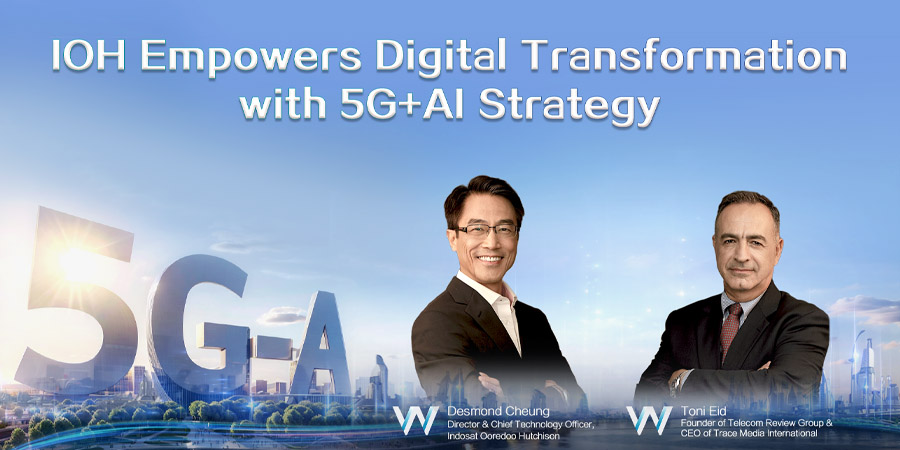During Mobile World Congress Shanghai 2024, Toni Eid, Founder of Telecom Review Group and CEO of Trace Media International engaged in an exclusive discourse with Desmond Cheung, Director and Chief Technology Officer, Indosat Ooredoo Hutchison (Indosat or IOH). The luminaries delved into Indosat's latest AI advancements, discussing how these developments drive digital transformation across various industries.
As a 56-year-old company, Indosat is currently strategically transitioning from a traditional operator into an AI-enabled technology provider. This transformation is designed to deliver a marvelous experience to its stakeholders.
To turn this vision into a reality, the network architecture must evolve to offer high performance, high reliability, determinism, and intelligence. This, in turn, will ensure the high-quality development of B2C, B2H, and B2B businesses.
Indosat: Propelling Indonesia's Transformation into an AI Powerhouse in Southeast Asia
When asked about the goal of this strategic transformation, Cheung started off by illustrating the bigger picture. At present, “Indonesia has the fourth-largest population in the world,” and by 2045, “the government’s ambition is to turn Indonesia into the fourth-largest economy in the world.”
Sharing a few data points to support this, Cheung highlighted that Indonesia’s GDP growth has hovered around 5% per annum over the past decade. Following the inception of AI technology, the GDP is set to grow by 6.9% CAGR which is 1.8 to 1.9% higher.
“Our ambition is to help Indonesia adopt the AI technology [needed] to become the AI powerhouse in Southeast Asia,” Cheung pointed out. “Indosat has started the journey to adopt AI [with] the goal of becoming an AI-native TechCo that will also deliver AI-enabled services to our mobile, fixed and business customers.”
Indosat's vision is to deliver hyper-personalized experiences and AI-driven enterprise services, such as sovereign cloud solutions. Additionally, the entity aims to empower its B2B teams to upsell new products and services.
Moving forward, “Our larger purpose is to empower every Indonesian through the development of AI capabilities across the nation. We are also aiming to deliver Indonesia’s first Bahasa Indonesia-based LLM – Sahabat AI,” Cheung stated.
B2B Innovation
According to Cheung, B2B customers are very important to Indosat Ooredoo Hutchison’s business. Thus, the deployment of Huawei’s NCE-T latency map is a very important capability and was built to provide better services for B2B customers.
“With the deployment of the NCE-T latency map, we can control optimize network latency in real-time, significantly improving the latency reliability which is crucial for latency-sensitive services such as financial transactions and telemedicine, ensuring users experience lower latency and higher service reliability,” explained Cheung.
Additionally, for the benefit of the B2B segment, Indosat has invested heavily in SRv6 segment routing technology for its B2B customers. The NCE-T capability will work hand-in-hand with the SRv6 segment, providing the best possible dedicated services with pre-defined bandwidth and service levels to suit each B2B customer’s needs.
Cheung also cited Indosat’s 400GE deployment in Jabotabek, Central and West Java, where the SRv6 deployment has reached 75%.
“To further enhance the digital capabilities of the IP network, we are working with our technology partners to build the digital twin of the IP technology and its underlying optical network. It will be the foundation of building our AI technology on top for the zero-touch operation to better serve our customers in the future,” expounded the CTO.
Transport Network Upgrade
Indosat’s network carries the traffic for over 100 million mobile broadband users (B2C) and a large number of B2B customers, including banks, financial institutions, industrial, hyperscalers, and many others; all of which require a high-capacity transport network.
Strategically taking into account the significant growth evident across all regions in Indonesia, Cheung expressed that Indosat is happy to deploy state-of-the-art solutions with the required high capacity and redundancy to suit their needs.
As part of this deployment, Indosat is working on a major project that focuses on deploying 400G and Super C+L 120-wave DWDM equipment in the second half of 2024. Indosat expects to complete the optical layer upgrade of the wavelength division system on Java Island.
“By 2025, we aim to migrate 55% of our data traffic to this new network with high performance and reliability,” continued Cheung.
Four Key Collaboration Areas
A crucial part of the discussion revolved around technological innovation and customer experience. Harnessing its techco capabilities, Indosat is collaborating with suppliers like Huawei to converge the two aforementioned niches. Cheung noted that this collaboration addresses four key areas through which Indosat strives to:
- Deliver marvelous experiences to its customers and connect underserved community in Indonesia.
- Provide high capacity at lower costs, ensuring that data usage increases without a proportional rise in customer costs.
- Offer compelling and personalized products and services to its customers.
- Ensure it remains environmentally sustainable and contributes positively to Indonesia through ESG initiatives.
Together, these four key areas act as a framework via which Indosat will refer to as it navigates the mercurial nature of technological innovation and customer experience. “This is exactly what we are doing. The technological innovation will not be meaningful if it cannot provide benefits to our customers; it has to be able to solve critical questions [and] problems for our customers,” concluded Cheung.










